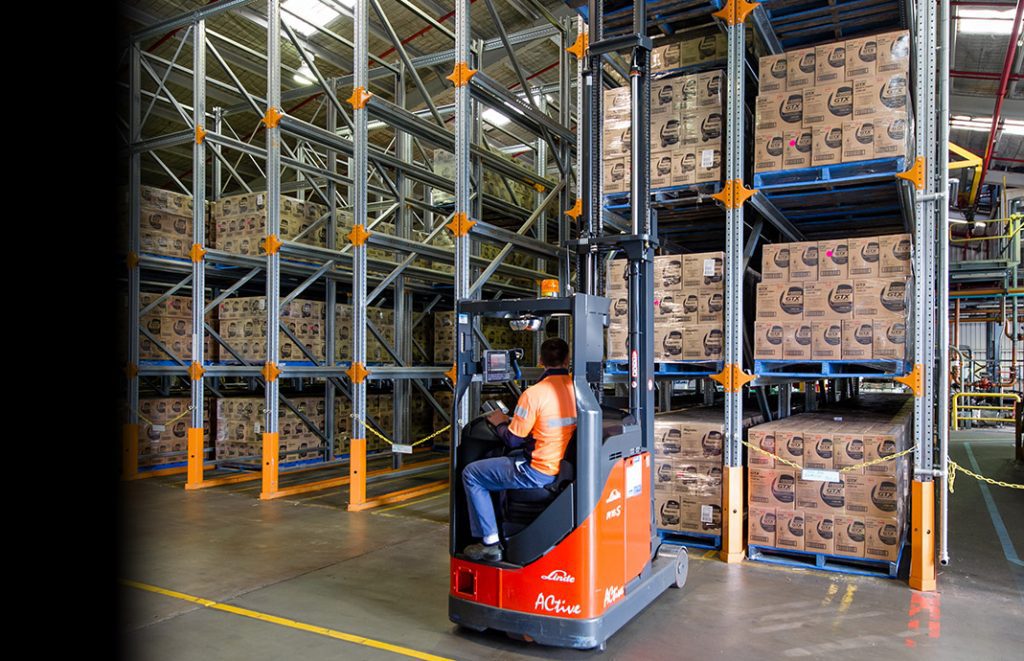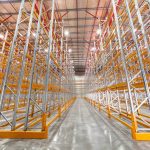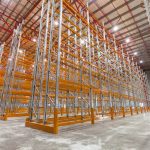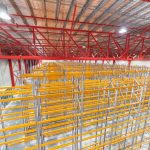Pallet racking comes in all different configurations depending on house dense you need to store things and how it needs to be accessed. Most of the time, denser pallet storage solutions means there’s less selectivity, but that’s not always a bad thing. For situations where there are a lot of pallets of the same SKU and those pallets don’t need to move very often, extremely dense storage can be a good thing. However, if pallets need to be moved frequently, some density might need to be exchanged for ease of access.

While there are many different options for dense pallet storage, common pallet racking types are drive-in pallet racking, double deep pallet racking, and push back pallet racking. But what’s the difference and what should you use? Let’s take a look at what these different types of pallet racking are and how they work.
Double Deep Pallet Racking
Let’s start with double deep pallet racking because it’s usually the least dense of the three.
As the name would suggest, double deep pallet racking stores pallets two deep. This effectively doubles the density of standard selective pallet racking. To access pallets at the back of a double deep configuration, of course the pallet in front needs to be removed. From there, a forklift with a special extended fork is used to get the pallet furth away.
Double deep pallet racking works well in situations where some density of storage is needed, but where there aren’t enough pallets of the same SKU to warrant storing them more than two deep. Since all the types of denser pallet storage we’re talking about here are first in, last out, double deep pallet racking is also good in situations where stock rotation is important. You may have a lot of pallets of the same SKU, but if you need to move older pallets sooner than newer pallets, it’s important that these older pallets aren’t stored well behind other stock.
In this way, double deep pallet racking can be a good balance between increasing storage density while still making sure pallets are relatively accessible. After all, to access any pallet, the worst case scenario is having to only move one pallet out of the way.
Push Back Pallet Racking
Push back pallet racking works by storing pallets on a slight incline. In this way, the next pallet to go on the racking pushes the other pallets back. As pallets are removed, they automatically slide forward for easy retrieval. In theory, there’s almost no limit to how far pallets can be stored, but of course there are limitations on the amount of weight that can be pushed back.
Like double deep pallet racking, push back pallet racking is also first in, last out, but since pallets can be stored very deep, the selectivity of pallets at the back is quite limited. This suites storage situations where there are enough pallets of the same SKU to warrant being stored behind each other and where either it’s not important to have to access older pallets or where stock rotation is high enough that pallets are the back of a push back racking system will be naturally rotated out frequently.
Of course this all depends on exactly what’s being stored in a warehouse and how often stock is coming in or out.
Drive-In Pallet Racking
Finally, we have drive-in pallet racking. Drive-in pallet racking can allow for very dense storage because there’s nothing to limit how far back pallets can be stored. Assuming there’s nothing in the way, pallets can be accessed quickly by driving a forklift into the racking itself.
Of course all of this means selectivity of pallets is diminished though. To allow forklift access, pallets in the same row and column need to be removed, rather than just a single row for push back pallet racking. Because of this, drive-in pallet racking, especially when it’s very deep, is only suitable for storage situations where there are many pallets of the same SKU being stored.
That being said, in some cross docking situations, where pallets may be stored in accordance to where they’re being shipped rather than SKU, the density afforded by drive-in pallet racking may also be worthwhile. It all depends on how the racking will be used.
Speak To Us About What Works Best
If you’re still unsure what kind of pallet of racking suits your storage needs, we’re more than happy to provide some advice. We’ve encountered a variety of warehouse storage situations and can help find the right solution for the specific needs for your business.




